Tracey Warr's Blog, page 17
April 4, 2020
Female Lords
The eleventh-century countess of Barcelona, Almodis de La Marche, was accused by the monk historian, William of Malmesbury, of being driven by ‘a furious and godless female itch’, which immediately struck me as a good reason to write her biography.
I’m working on that biography now and have expanded it to incorporate the lives of her two sisters: Raingarde, who was countess of Carcassonne, and Lucia, who was countess of Pallars Sobira. Lucia is pictured below in a fresco she commissioned for a mountain chapel in the Pyrenees. I was lucky enough to be a writer in residence at the nearby Centre d’Art i Natura in Farrera and to visit the chapel, which now has a (very good) replica of Lucia’s frescos in situ, while the originals are on display in MNAC in Barcelona.
[image error]Lucia de La Marche, Sant Pere del Burgal.
March 31, 2020
Virtually Dartington
The Dartington Estate (where I live and work and am currently in lockdown) has had to temporarily close due to the pandemic, but Virtually Dartington is open and offering you Will Kemp writing on Merce Cunningham at Dartington; free arthouse films via Mubi, courtesy of The Barn Cinema; footage from the Schumacher College and Dartington archives, such as Lewis Hyde and Martin Shaw on The Art of the Trickster; virtual walks in the Dartington gardens and deer park; Arts and Learning podcasts; Soundart Radio; our recent series of LASER Talks: Art After the Collapse; and much more. Follow the LEARN link in the top menu to find out about our postgraduate programmes at Schumacher College and Dartington Arts School. We have a Virtual Open Day coming up this month.
March 21, 2020
Impressive Books
My publisher, Impress Books, has changed hands. Immense thanks to Richard Willis who founded Impress Books and launched my career as a published historical fiction novelist. And hello, Jeff Collyer, who has taken over and has lots of exciting plans in the pipeline for the Impress Books list. Thank you, too, to my fellow Impress Books authors who are full of such camaraderie, as well as being astonishing writers. Here are some of their recent books.
[image error][image error][image error][image error][image error][image error]Truth Sister, Phil Gilvin’s future fiction novel set in the 22nd century Women’s Republic of Anglia; Sunwise, Helen Steadman’s historical novel about a witch-finder and his prey; She’s Fallen, Alex Clare’s crime novel with DI Robyn Bailey on the case of a young woman who has plunged from a hotel balcony; Tree Magic, Harriet Springbett’s story of a girl who can communicate with trees; Assembly of the Dead, Saeida Rouass’s novel about a detective hunting down a murderer in early 20th century Tangiers; and A Stranger in Paris, Karen Webb’s funny and poignant memoir of adapting to life in France.
My next medieval novel, The Anarchy, is out with Impress Books in June and can be preordered now. The Anarchy is the final book in a trilogy on the struggle between the Welsh and the Normans, focused on the life of the Welsh noblewoman, Nest ferch Rhys.
[image error]
If you start now with book 1 – Daughter of the Last King – you should be ready for book 3 by June. Blogger Poppy Coburn declared: ‘I practically inhaled the contents of this book.’
February 29, 2020
Summer Workshop, Girona, Spain
26–31 July 2020
Mas Carbó, Sant Hilari de Sacalm, Girona, Spain
A five-day workshop exploring the concept of Wu Wei through Tai Chi, improvisation and writing led by Tew Bunnag, Denys Blacker, and Tracey Warr.
Wu Wei is the sense of letting go, of letting yourself be spacious so that the universe can come in. It doesn’t mean no in the sense of not doing anything, rather no in the sense of the absence of trying and effort and ambition and duality.
500 euros including tuition, food, and lodging. Deadline 10 July 2020. Contact: blackerdenys@gmail.com
February 23, 2020
The Water Age at the seaside
Thank you to a reader for this shot of my future fiction stories, The Water Age, being read in Cornwall, and for the comment that it is an ‘intriguing, sensual and sad book, reflecting with such careful insight on the nature of water and our nature as watery beings’.
The book is a collection of short stories all engaging with water. Meanda is set on a watery exoplanet and tells the story of first contact between a human and the amphibian inhabitants. Another story imagines scientists in a top secret lab on Iceland who are working to graft themselves with algae.
February 20, 2020
Tracking stories through time and across landscapes
Sarah Gray’s interview with me on Soundart Radio discussing my medieval fiction, my watery future fiction, and new arts postgrad courses at Dartington Arts School – MA Poetics of Imagination and MA Arts and Place. Listen in:
February 2, 2020
Thwarted Lovers
Attended a riveting event yesterday where Martin Shaw retold the story of Tristan and Iseult in one day to an audience of 80 in Dartington’s medieval Upper Gatehouse. With lashings of humour and feeling, Shaw led us into an exploration of how the story conjures the rapture and damage of love. Romantic love thrives on thwarting and the love triangle of Tristan, Iseult and Mark involves such thwarting again and again. Together we tracked the agonising twists and turns of the lovers’ erotic jeopardy and felt how an all-consuming love can become stifling, depleting and vampiric. Shaw kept us rapt to the story’s continuing resonances in the contemporary world and our own lives.
In his preamble, Shaw referenced the poetry of the troubadour duke, Guillaume IX, and the female trobairitz. A few years ago, I collaborated with artist Tania Candiani on a project in the Lot Valley in France. I wrote a song based on a lyric by the Occitan female troubadour, Comtesse de Dia, which was recorded by a local Occitan singer in one of the nearby medieval churches. My adaptation replaced the two lovers in Dia’s song with the Earth’s lament to the human species.
[image error]Tania Candiani, Landscape Sound Amplifier, Site specific installation, Exoplanet Lot, Saint Cirq Lapopie, France, 2016. Photo: Yohann Gozard. Courtesy of the artist. Exoplanet Lot was organised by Maison des Arts Georges et Claude Pompidou, Cajarc.
Candiani installed the amplification sculpture pictured here to enable people to listen from the clifftop to the song resonating in the Lot Valley below. You can listen to it here.
Chant Trobairitz, made for Tania Candiani, Landscape Sound Amplifier. Lyrics by Tracey Warr, adapted from a song by the Comtesse de Dia.
The song lyrics are published in English in my book The Water Age and Other Fictions, which is available on Amazon and other outlets.
Martin Shaw and I will be teaching the new MA Poetics of Imagination at Dartington Arts School starting in September 2020.
January 25, 2020
Norman silver bird brooch
Writing on a Norman silver mine in the final stages of editing my next novel, The Anarchy. Found this exquisite Norman silver bird brooch to help with writing the scene.
January 13, 2020
The Gerona Beatus
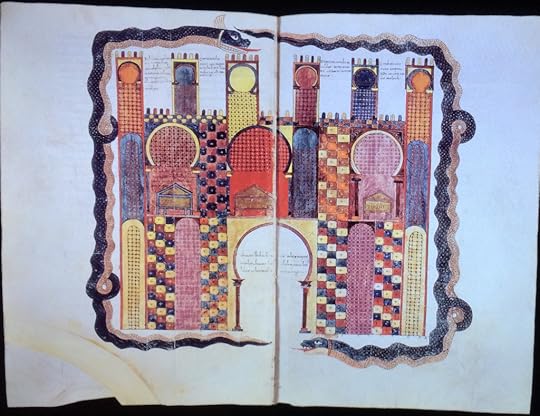 The Gerona Beatus, 975, Girona Cathedral, Spain
The Gerona Beatus, 975, Girona Cathedral, Spain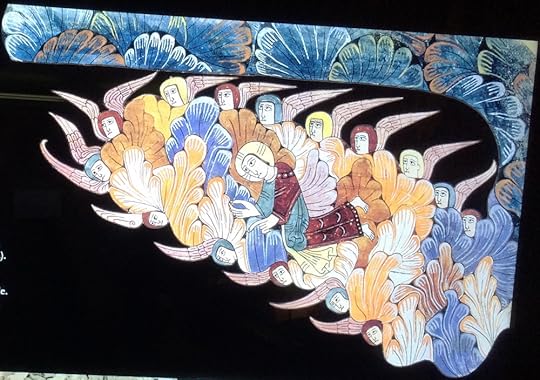
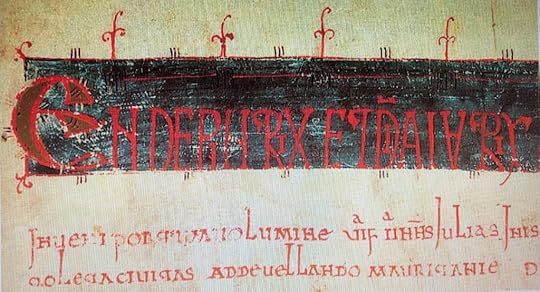 Colophon giving the name of En first: ‘En, painter and helper of God’, followed by the name of her collaborator, Emeterius
Colophon giving the name of En first: ‘En, painter and helper of God’, followed by the name of her collaborator, Emeterius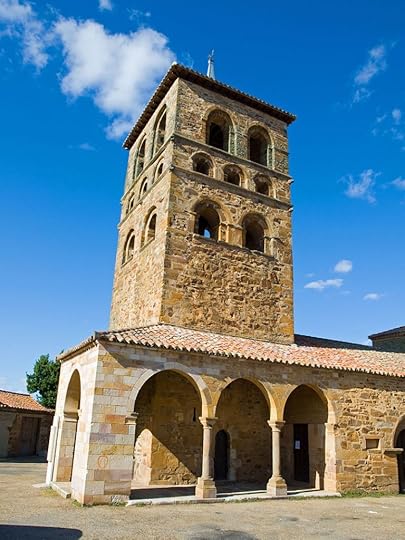 Romanesque Tower at the 9th century monastery of San Salvador de Tábara
Romanesque Tower at the 9th century monastery of San Salvador de Tábara 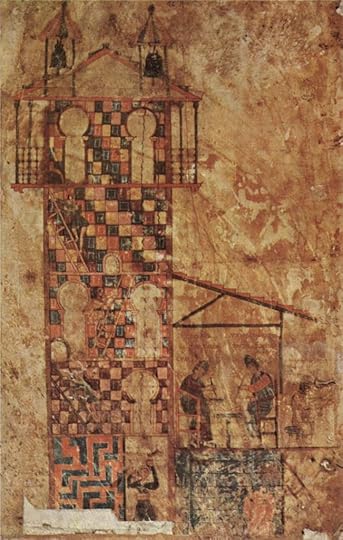 Illustration from the Gerona Beatus showing En and Emeterius working in the scriptorium tower of the monastery
Illustration from the Gerona Beatus showing En and Emeterius working in the scriptorium tower of the monastery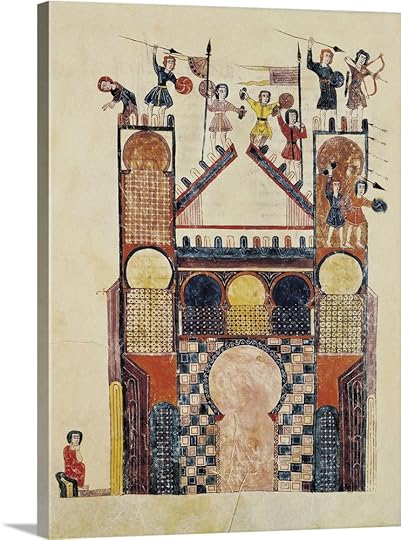
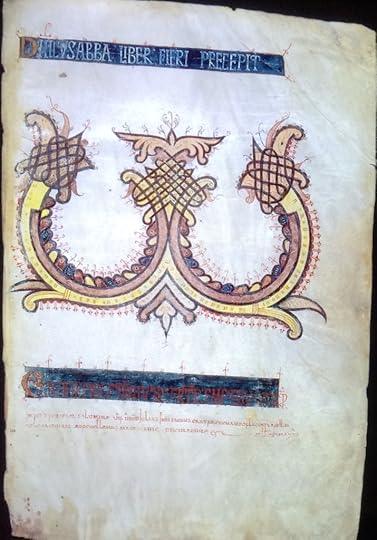 The Letter Omega in the Gerona Beatus
The Letter Omega in the Gerona Beatus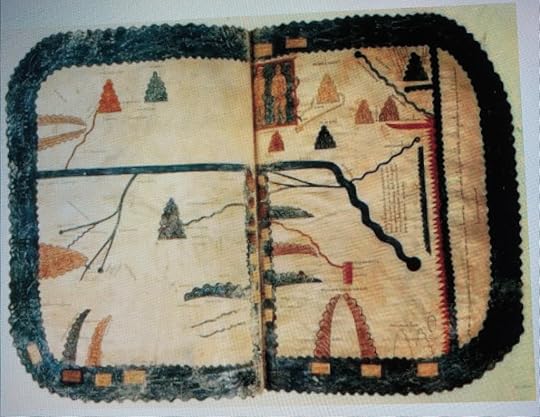 Mappa Mundi from the Gerona Beatus
Mappa Mundi from the Gerona Beatus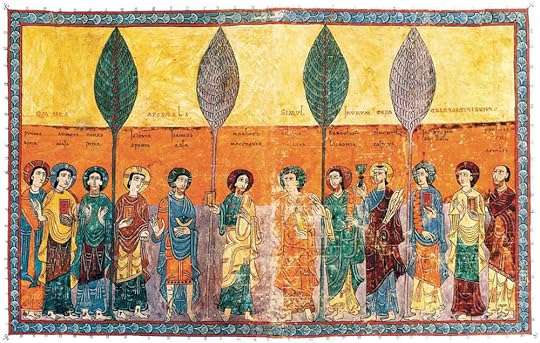
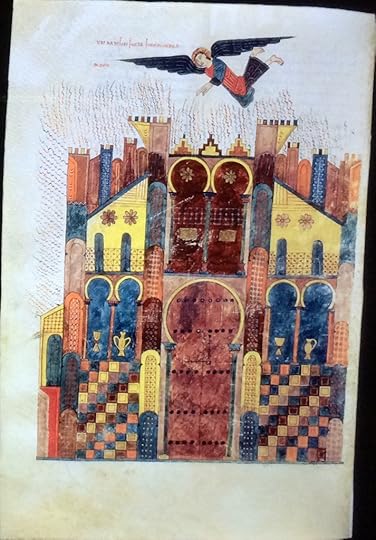
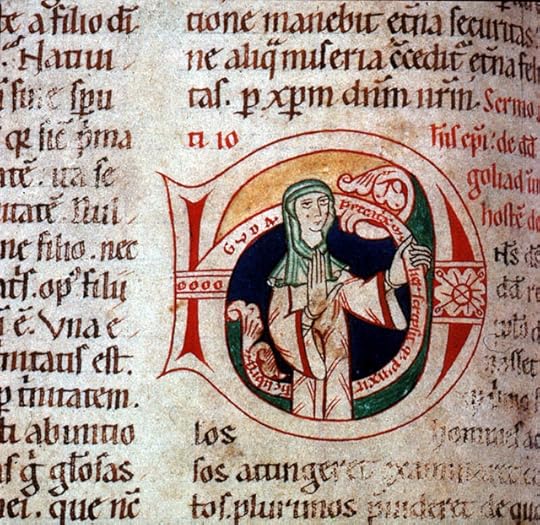 Self-portrait of the artist in the Frankfurt Homilary: ‘Guda, a sinner, wrote and painted this book’
Self-portrait of the artist in the Frankfurt Homilary: ‘Guda, a sinner, wrote and painted this book’ I was recently in Girona carrying out research on a biography I am working on about the lives of three sisters who lived in the 11th century: Almodis de La Marche, Raingarde de La Marche and Lucia de La Marche. More on the sisters and the biography in a later post. In this post, I wanted to write about an extraordinary 10th century book that I saw in Girona Cathedral. The book is a copy of the Commentary on the Apocalypse of St John written by the Spanish monk, Beatus of Liébana, in 776.
The Girona version of Beatus’s Commentary is one of 29 surviving copies of the text and was completed in July 975. There are at least three extraordinary aspects to the Girona Beatus: the quality of its illustrations, which are executed in the Mozarabic style; that most of those illustrations were painted by a woman called En,[1]who was probably a nun; and that, in the book, she left her name in a colophon, identifying herself as the principle artist, and a portrait of herself and her collaborator, a monk named Emeterius.
En and Emeterius lived and worked at San Salvador de Tábara monastery, which was a mixed community of nuns and monks with a superb scriptorium that produced a number of significant illuminated manuscripts. A little later in the medieval period monasteries for men and convents for women became strictly separated, but in the early medieval period there were a number of such mixed religious communities.
The Mozarabs were Iberian Christians living in Al-Andalus, the Muslim-conquered territories of Spain in the 8th to the 11th centuries. The Mozarabic style in art and architecture blended elements of Islamic art and decorative traditions using geometry, rich colours, ornamented grounds, and stylized figures.
In an article on the Beatus manuscripts, Therese Martin and John Williams have argued that there was a large group of female scribes and illuminators across Europe, although most of them did not leave their names on their work. They cite the 12th century German nun Guda as another example of a female medieval artist who left her self-portrait in a book, which in her case, was the Frankfurt Homilary, where she wrote ‘Guda, a sinner, wrote and painted this book’.[2]
Martin and Williams have asserted that presumptions have been made about power in the Middle Ages and about men’s versus women’s place, agency, and authority, which have led to the forgetting of the actual roles of early medieval women.[3]This argument is true too in the case of the biography I am writing on the three La Marche sisters. I am seeking to recover the memory of the roles of medieval women that have been overlooked and smothered beneath false assumptions, and seeking to restore the memory of women to the stories we choose to tell about the Middle Ages.
[1]Some sources give her name as Ende but in ‘Women’s Spaces—Real and Imagined—in the Illustrated Beatus Commentaries’, Arenal, 25:2, July-Dec 2018, 357-396, Therese Martin and John Williams have argued that this is a misreading of the colophon, which they translate as ‘En, painter and helper of God’.
[2]Martin & Williams (2018).
[3]Martin & Williams (2018).
January 12, 2020
Offcuts from research
This month, I’m working on the final rewrites for my next historical novel, The Anarchy. The book will be published on 2 June and you can preorder it here.
In the course of researching my books, I’m forever having to keep the story focused and leave out some of the fascinating characters and facts from history. However, I will be writing a series of posts and articles on them instead.
Alongside the publication of my last novel, I wrote a post for the English Historical Fiction Authors blog on Nest’s pioneering husband, Gerald of Windsor, who foiled the Welsh siege of Pembroke Castle with a fake letter and a lot of bravado, and who escaped from another castle under attack by wriggling down a medieval toilet chute.
Keep an eye out for forthcoming posts and articles on the ‘offcuts’ from my current research including:
[image error]medieval murder
Devious medieval murder methods
Was King Henry I a proto-feminist? How much are we are wishfully ‘reading back’ into history on issues such as gender, or are we rediscovering events that have been buried under later attitudes and propaganda?
Is there any weight to the controversial argument that the Welsh warrior princess Gwenllian ferch Gruffudd ap Cynan could be the author of The Four Branches of the Mabinogion – the famous Welsh medieval stories?
Uncovering the motivations of the treacherous Welsh prince, Cadwaladr ap Gruffudd ap Cynan (Gwenllian’s brother) who tried to displace his brother by invading with Dublin Vikings; collaborated with the Normans; and was very likely behind a string of brutal murders of other Welsh princes.
Inside the slippery intricacies of the mind of Bishop Henry of Blois, brother of King Stephen, who thwarted Henry’s ambitions to be Archbishop of Canterbury. Henry was a papal legate embroiled in Vatican politicking and was an avid relic collector. He swapped sides repeatedly and impactfully in the civil war between his brother, the king, and his cousin, Empress Matilda.
[image error]The mummified hand of St James, a relic that Henry of Blois ‘borrowed’ from Reading Abbey for 19 years
[*Amazon is currently giving November as the publication date but we are working towards a June release.]



